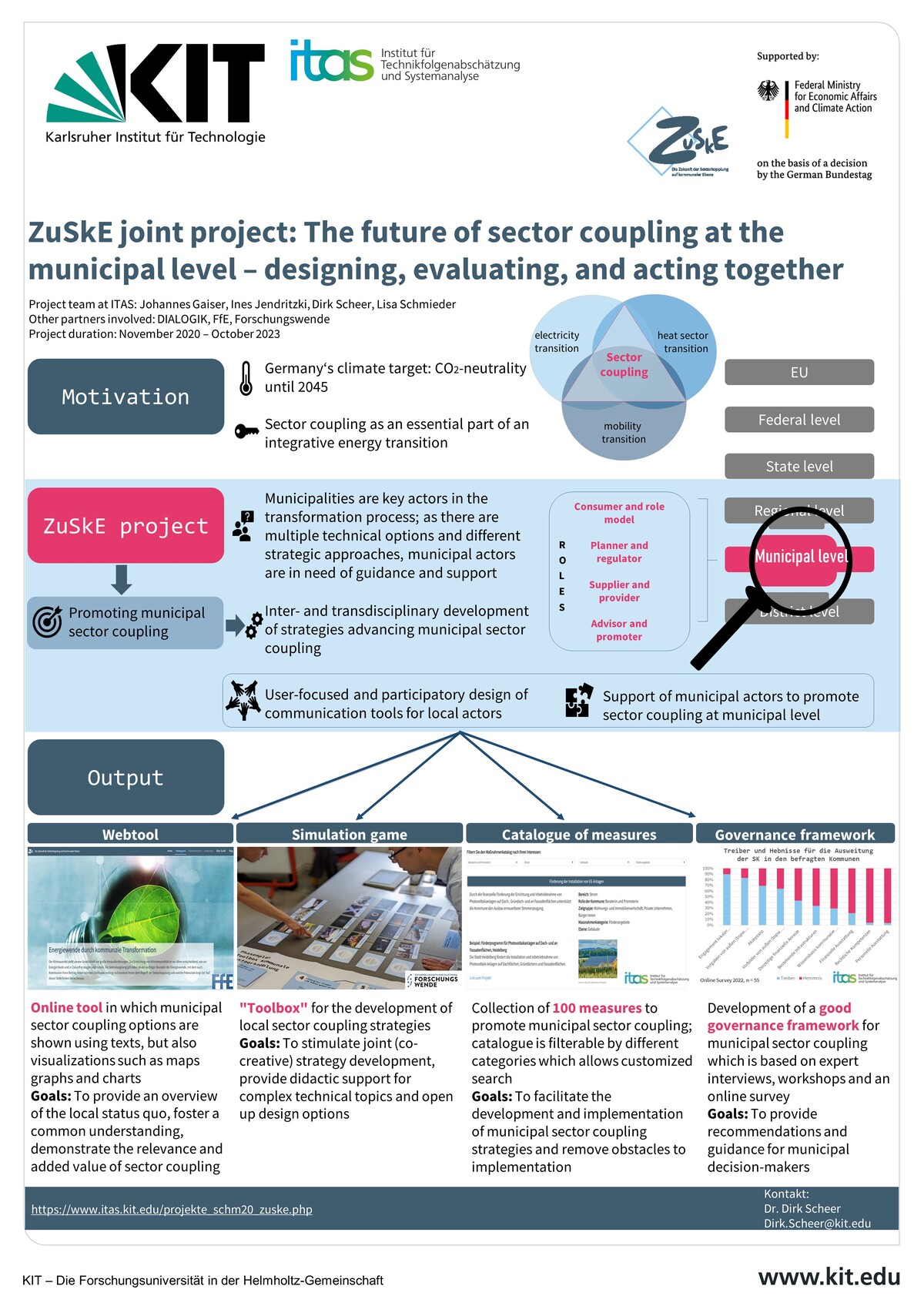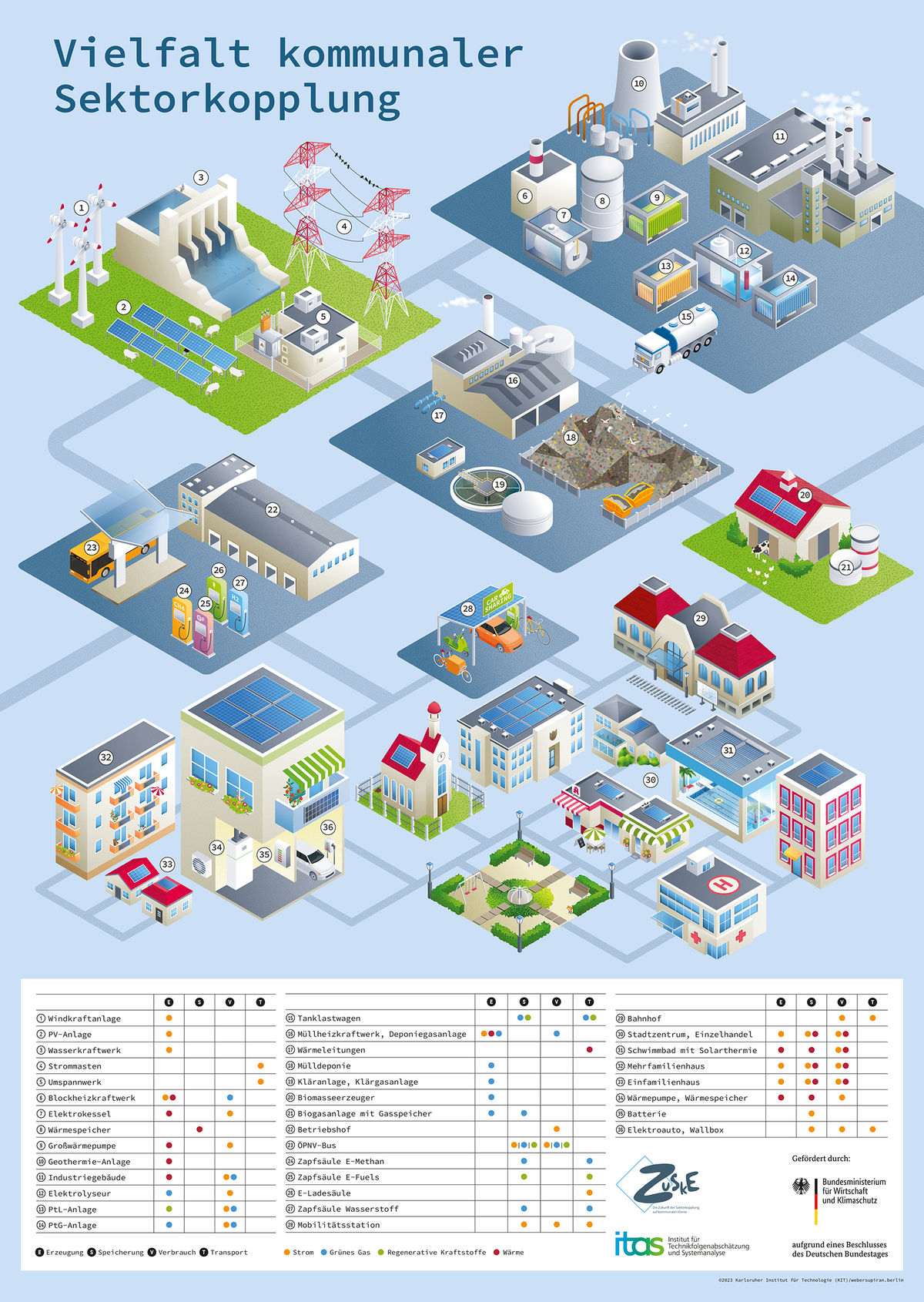ZuSkE joint project: The future of sector coupling at the municipal level – designing, evaluating, and acting together
- Project team:
Scheer, Dirk (Project leader); Johannes Gaiser, Ines Jendritzki, Julian Pfeiffer, Lisa Schmieder
- Funding:
Federal Ministry for Economic Affairs and Energy
- Start date:
2020
- End date:
2023
- Project partners:
DIALOGIK gemeinnützige Gesellschaft für Kommunikations- und Kooperationsforschung mbH, Research Center for Energy Economics (FfE), Zivilgesellschaftliche Plattform Forschungswende
- Research group:
Project description
The significant reduction in energy demand, the expansion of renewable energies, and increased sector coupling are central prerequisites for the success of the energy transition and thus for achieving the climate targets set out in the Paris Agreement. Local authorities are key players in this profound transformation process of the energy system towards a climate-friendly energy system. By networking with local actors, they can make an important contribution to the implementation of the energy transition. This also and in particular applies to increased sector coupling. However, the options and technologies available for coupling the different sectors electricity, heating, cooling, industry, and mobility are diverse and complex. In addition, various actors are involved in the coupling process of these sectors, such as municipal utilities, local mobility providers, energy and building cooperatives, other companies, city administrations, and also citizens who work together on the transformation of the energy system.
Against this background, the aim of the ZuSkE joint project is, on the one hand, to develop and evaluate municipal sector coupling strategies in an interdisciplinary and transdisciplinary manner. On the other hand, the project focuses on a user-centered, participatory development of communication tools for local actors to support the municipalities in the transformation process (and beyond). The project is carried out using the example of three municipalities of different sizes and regional conditions. These are Walldorf (Baden-Württemberg) with approx. 16,000 inhabitants, Freilassing (Bavaria) with approx. 16,000 inhabitants, and the city of Berlin with approx. 3.75 million inhabitants. The project also aims to ensure that the methodology and process design can be transferred to other municipalities.
ITAS coordinates the project and is involved in the following research activities:
- Inter- and transdisciplinary access to communal sector coupling: Workshop-based development of needs and scenarios in the municipalities, identification of literature-based transformation paths and options for action for sector coupling strategies
- Good Governance for municipal sector coupling strategies: Development of a “map” for sector coupling strategies and a framework for good governance for municipal sector coupling based on participatory observation during the workshops, literature analysis, and interviews to verify and complete the results
- Reflection and transfer of the methods and results: Identification of similarities and differences between the municipal sector coupling strategies, reflection of the methods and transfer activities to other municipalities, development of overarching strategies for action in terms of multi-level governance (federal, state, municipal)
A more detailed description of the project activities of all participants is available for download as a PDF (in German).
Impressions from the ongoing project
“What is municipal sector coupling? How does it affect me?” These are questions frequently asked by citizens and stakeholders involved in the ZuSkE project. In order to provide easy-to-understand answers, ITAS and the WEBERSUPIRAN agency have developed a system illustration of municipal sector coupling. But what exactly is its purpose and what insights does it offer?
- It shows the diversity of sector coupling at the municipal level by presenting a comprehensive overview of the overall system.
- It gives an idea of the components that can contribute to a climate-neutral energy supply in municipalities.
- It clearly illustrates the well-known and less-known elements of sector coupling.
Established concepts such as e-mobility, heat pumps, and the use of biogenic residues in biogas plants are considered alongside innovative approaches, e.g., synthetic fuels, electrolysis plants, or power-to-X plants, which are still in the development phase. Moreover, the illustration includes public facilities as well as private residential buildings and industrial plants. Thus, it does not only reflect the broad range of technologies but also their integration into the larger municipal landscape. We can promise: There is a lot to discover and it is worth taking a closer look!
The caption explains the connections between the different elements and the energy carriers. These are categorized into electricity, green (CO2-neutral) gas, renewable fuels, and heat, which are either provided, stored, consumed, or transported. While the world of municipal sector coupling seems to be complex at first glance, the illustration reveals exciting connections, waiting to be explored to make tomorrow’s world tangible today.
Publications
Sektorkopplung als sozio-technischer Kitt der Energiewende
2025. Mit Energie gestalten! Perspektiven zur Energiewende als Chance für ländliche Räume. Hrsg.: M. Kaiser, 62–69, Flyeralarm
Kommunale Sektorkopplung als Mosaikstein der Energiewende
2024. GWF / Gas, Erdgas, 165 (12), 79–84
Kommunale Ebene gefragt : Sektorkopplung auf kommunaler Ebene erfordert Technik und Vernetzung
2024. Stadt + Werk, 2024 (5/6), 8–11
Die Zukunft der Sektorkopplung auf kommunaler Ebene (ZuSkE) : gemeinsamer Endbericht
2024. Karlsruher Institut für Technologie (KIT). doi:10.2314/KXP:1921429208
Ausblick: Kommunale Sektorkopplung
2024, October 10. Kommunale Energiewende: Das Wärmeplanungsgesetz in der Praxis (2024), München/Online, October 10, 2024
Kommunale Sektorkopplung als Gestaltungsaufgabe
2024. Die Sektorkopplung als Vektor zur Flexibilisierung des Stromsystems (2024), Berlin, Germany, March 21, 2024
Energiesystem der Zukunft als sozio‐technische Herausforderung
2024. Gebäudetechnik Kongress (2024), Munich, Germany, January 19, 2024
Experimenting the territories: stimulating bottom-up approaches for innovation
2023. Revue Passages, 217, 41–43
Municipalities as change agents? Reconsidering roles and policies in local energy sector-coupling
2023. Energy Research & Social Science, 103, Art.-Nr.: 103210. doi:10.1016/j.erss.2023.103210
Municipalities as change agents? Reconsidering roles and policies in local energy sector-coupling
2023. 6th Nordic STS Conference (2023), Oslo, Norway, June 7–9, 2023
Von 100 lernen - der Maßnahmenkatalog kommunale Sektorkopplung
2023. Abschlusskonferenz ZuSkE-Projekt (2023), Berlin, Germany, October 24, 2023
ZuSkE-database: Future of sector coupling on municipal level
2023. 4th Expert Group: Roadmap to 100 % Renewable Energy in the EU, Meeting “Sector integration and neighbourhood policy" (2023), Online, October 9–10, 2023
Die Zukunft der kommunalen Sektorkopplung auf kommunaler Ebene - gemeinsam gestalten, bewerten und handeln
2023. Kommunale Wärmeplanung - Recht und Praxis (2023), Online, September 26, 2023
Sozio‐technische Herausforderungen beim Umgang mit neuen Technologien
2023. 4. Wasserstoffmotor Konferenz (WMK 2023), Karlsruhe, Germany, September 12, 2023
Werkzeuge für die kommunale Sektorkopplung
2023
Energiewende „bottom-up“ – sektorübergreifend, gemeinschaftlich und lösungsorientiert
2022, October 6. 5. INSIST-Tagung: Interdisciplinary Network for Studies Investigating Science and Technology (2022), Berlin, Germany, October 6–7, 2022
Experimenting the territories: stimulating bottom-up approaches for innovation
2022. 7ème Forum Franco-Allemand: Territoires, Mobilités, Transition énergétique et numérique: Quelle pertinence sociale? (2022), Strasbourg, France, October 21, 2022
Kommunale Sektorkopplung – Regional gestaltete Energiewende
2022
Wie wandelt die Wende? Wissenschaftsperspektiven auf Transformationsmechanismen der Energiewende
2021. Soziologie der Nachhaltigkeit, 313–324, transcript Verlag. doi:10.1515/9783839451991-015
Contact
Karlsruhe Institute of Technology (KIT)
Institute for Technology Assessment and Systems Analysis (ITAS)
P.O. Box 3640
76021 Karlsruhe
Germany
Tel.: +49 721 608-22994
E-Mail



